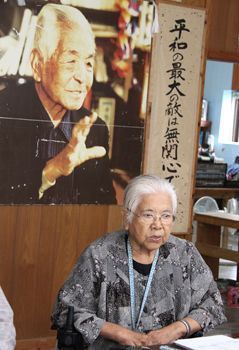Iejima peace museum’s Jahana says Henoko, Takae and Iejima are one, still at war after 71 years

: Etsuko Jahana, director of Iejima’s Anti-war Peace Museum, talks about peace while sitting in front of a photograph of Shoko Ahagon on November 22 in Ie Village
December 5, 2016 Ryukyu Shimpo
By Ayako Sakaguchi
(Iejima) “Henoko, Takae, and Iejima—the three are all one. Anger and frustration continue every day. Even after the passage of 71 years, we are still at war.” On November 22, Etsuko Jahana, 78, director of the Iejima Anti-war Peace Museum, made eye contact with visitors to the museum as she spoke passionately to them.
Jahana’s talk was part of a tour planned by a Tokyo travel agency to learn about the history of Iejima.
She spoke to twelve visitors from both Okinawa and other parts of Japan. Jahana, who long participated in the peace movement with Shoko Ahagon, spoke about the helipad construction being carried out in the U.S. military’s Northern Training Area, which spans Higashi Village and Kunigami Village. “What is this situation, in which Okinawans are fighting with all their might? The central government has taken no responsibility since the Battle of Okinawa, and feels no remorse. It is so frustrating, I just want to ask, what on earth is going on?” Jahana criticized the government’s forceful pursuing of the helipad construction.
Jahana reflected on the Battle of Okinawa 71 years ago and explained the devastating damage experienced by Iejima, saying, “Everything on this island was destroyed. Not a single tree or house was left standing. The enemy was brought to this small island, and corpses became scattered at our feet. The government is the one who brought about that man-made disaster.”
After the war, the islanders of Iejima had their land forcibly seized by the U.S. military. In order to save their land, Ahagon and others engaged in a long fight of nonviolence and peaceful resistance. “Okinawans engaged in sit-ins day and night, 24 hours, even sleeping at the sit-in site,” Jahana explained. “We had many successes. In order to stave off war, many people’s voices are needed. A peace movement can’t be built with only a few people.”
In Iejima, the U.S. Marines’ MV-22 Osprey aircraft fly overhead, and noise issues are increasing. In 2015, the number of times that noise levels above 60 decibels were recorded near Iejima Auxiliary Airfield reached 2.5 times the 2013 figure.
Jahana expressed concern that the Osprey will fly from Iejima to Takae and Henoko and threaten the livelihoods of Yambaru residents. “Okinawans alone can’t bring about peace. All Japanese people are responsible for whether we can overcome the current situation. I want people on the Japanese mainland to be aware,” she said.
(English translation by T&CT and Sandi Aritza)
Previous Article:Airstrip expansion and helipad construction at Ie Jima Auxiliary Airfield proceeding steadily
Next Article:Director Isao Takahata makes appeal to (the President), requesting halt on Takae Helipad construction in open letter signed by over 100 people
[Similar Articles]
- Inheriting non-violent way of life from father of the Okinawan civil rights movement
- Fundraising begins to repair and preserve “Solidarity Dojo,” symbol of resistance to US military
- Nuchi-du-Takara-no-Ie celebrates 30th anniversary
- Villagers hold protest rally against US Osprey and F-35’s training on Ie Island
- Shoko Ahagon’s legacy of the Ie Land Struggle and Solidarity Dojo passed on to Ie Elementary School students
 Webcam(Kokusai Street)
Webcam(Kokusai Street)


